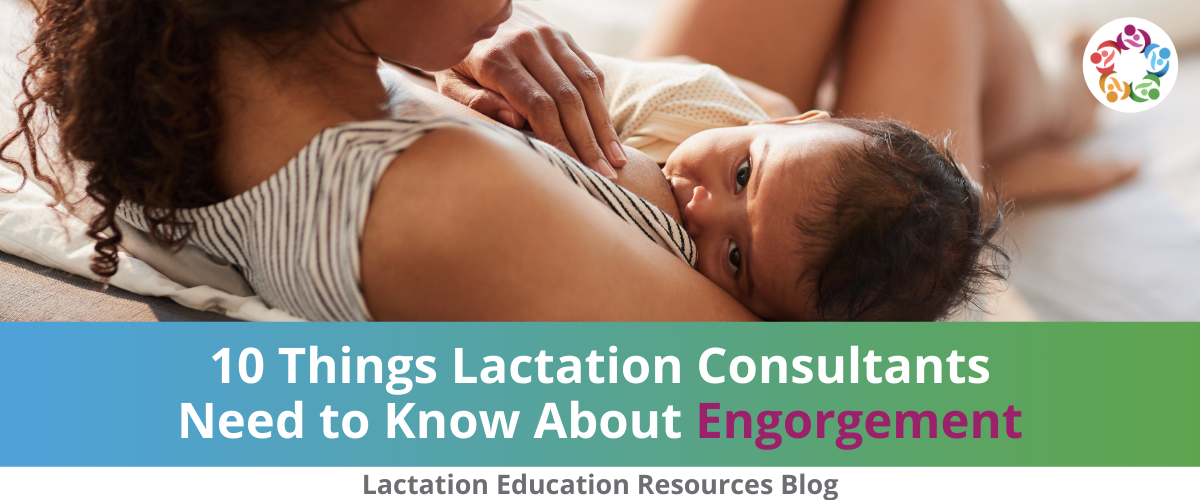

Breast engorgement … it’s a common problem, but did you know that it can also be very serious, even leading to loss of milk supply and failed breastfeeding? According to Nekisha Killings, MPH, CLC, IBCLC, RLC, engorgement is one of the most common yet least understood lactation challenges. Here, based on Killing’s Lactation Education Resources class “Engorgement and Mastitis,” are 10 things IBCLCs need to know.
1) What is engorgement?
Engorgement happens when breasts become swollen and distended due to accumulated milk and edema.
2) When does it happen?
Engorgement is typically seen at 30-72 hours postpartum, when milk onset occurs and the breast is still under endocrine control. It can happen a little later in parents who have had a c-section.
3) What are the two types of engorgement?
Engorgement comes in two varieties: physiologic and pathologic. Physiologic engorgement is the normal breast fullness and enlargement that occurs with milk onset, usually around postpartum day three. The skin is tight, and the breasts feel warm, but discomfort is mild. There is minimal edema, and most importantly, milk will still flow—baby is able to transfer milk from the breast, or the parent can express milk.
With pathologic engorgement, breast enlargement is more pronounced. Skin is extremely tight, appearing taut and shiny. The breasts are painful and hot, and fever may be present. In addition to milk build-up, there is severe edema. Lumps and hard areas may be palpable. When engorgement reaches this stage, milk will not flow, and it becomes hard to drain the breast, either by nursing or expressing milk.
4) What’s happening inside the breast?
When milk and edema build up, they put back pressure on the alveoli, which change shape as a result and may rupture. Circulation to the alveoli is also compromised, further damaging them. Feedback Inhibitor of Lactation (FIL) builds up in the breast, signaling it to make less milk and promoting cell involution.
If engorgement progresses too far and is not treated soon enough, some alveoli will die. They will not be replaced until a future pregnancy—meaning milk supply for the current baby can take a significant hit. Because of this, pathologic engorgement poses a big risk to breastfeeding outcomes—and the reason Killings calls it a “true and real breastfeeding emergency, which can lead to failed breastfeeding and early weaning.”
5) What causes it?
The cause of engorgement is failure to adequately drain the breast. This can happen when a baby is taking a shallow latch, or “nipple feeding.” In fact, according to Killings, shallow latch resulting in inadequate milk transfer is probably the most common cause of engorgement.
6) What factors increase risk?
Parents with flat or inverted nipples are at increased risk, because baby may have a harder time latching deeply. Non-elastic areolar tissue is another parent risk factor. Long labor, induction, and c-section are also risk factors, since these often involve large amounts of IV fluids which can contribute to edema in the breast. Parents who delay feedings or nurse on a schedule are also more likely to experience engorgement.
When a baby is premature, requires NICU care, has tongue tie, or has jaundice, the parent is also at increased risk for engorgement. All of these factors can lead to less frequent or effective feedings.
7) How do you treat engorgement?
The key to treating engorgement is to remove milk regularly and effectively. Encourage frequent nursing, with optimal latch and positioning. If flat nipples are an issue—or if the engorgement is causing flattening of nipples—teach the parent to shape the breast using reverse-pressure softening, or try hand-expressing or pumping before feeding. NSAIDs can be used for pain and swelling. Massage can also be a helpful tool, especially when used during feedings. Massage from the periphery toward the nipple, using non-scented lotion.
8) Should you suggest heat or cold?
Heat can play a role in helping encourage MER and milk drainage, so using it briefly before feedings (through warm compress or standing in the shower) is helpful. However, too much heat can actually increase congestion in the breast, so use it only for a limited time. Suggest cold compress after feedings—this will slow the refilling process and reduce congestion. Apply cold to the breasts for 20-30 minutes after each feeding. Ice packs, gel packs, and frozen vegetables all work well.
For the most stubborn engorgement, Killings recommends alternating between heat and cold. The parent can pump while heat is applied and apply ice after.
9) What about pumping?
Should the parent pump to reduce engorgement, or will pumping just create more supply? It’s a controversial issue, according to Killings, but especially in pathologic engorgement, the most important thing is removing milk to reduce stress on alveoli, promote lymph and fluid drainage, reduce the build-up of FIL, and decrease the risk of further complications like mastitis, so advising the parent to pump to relieve engorgement is sound advice.
10) What are key steps to prevention?
Regular, effective milk removal from the start is the key to avoiding engorgement. According to Killings, all pregnant and newly delivered parents should be taught the following steps: Nurse early and often; nurse on demand; allow baby to finish the first breast first; ensure correct latch and positioning. If baby is not nursing well, parents should be urged to hand express or pump milk regularly and frequently. Parents of babies in the NICU or babies with jaundice should be started pumping ASAP, both to bring in a good supply and to avoid engorgement.
For a parent struggling with engorgement, prompt, effective treatment can mean the difference between subsequent low milk supply and early weaning and meeting their feeding goals. For more on engorgement, including more on alternative therapies, enroll in the LER course, “Engorgement and Mastitis.”
Buy Now
Buy Now